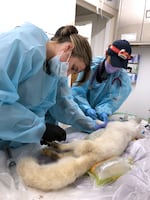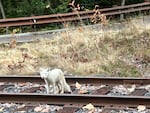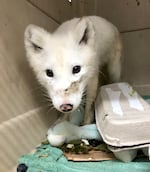
In this provided photo from Oct. 13, 2024, an arctic fox is sheltered at the Bird Alliance of Oregon, after being spotted in Portland last week. After her arrival at the facility on Saturday, an exam confirmed her species, and determined the young female was hungry and dehydrated. The Bird Alliance is working with the Department of Fish and Wildlife to determine her next home.
Courtesy of Bird Alliance of Oregon
An arctic fox spotted wandering in Portland last week is now being cared for by the Bird Alliance of Oregon, after someone approached by the small white mammal took it to the group’s wildlife care center on Saturday.
The fox was captured in Willamette Park, a short distance from where it had first been sighted.
Photos and video of the animal were first posted online Wednesday, fueling speculation about its origins. Some commenters thought it might be a very young red or gray fox with leucism, which can cause an animal to partially lose pigmentation — so its skin or fur might be mostly white, but not entirely.
Here’s what wildlife officials have learned about the animal so far: She – yes, the fox is female – is young, but not a kit. She was hungry and dehydrated when taken in, but appears to have been cared for by people until she got lost. And she doesn’t have an official name, but one of her current guardians has taken to calling her Foxy.
“This arctic fox probably takes the cake for the most interesting thing I’ve seen here,” said Ashley Lema, wildlife care center manager with the Bird Alliance, formerly known as Portland Audubon.

In this provided photo from Oct. 14, 2024, an arctic fox is examined under anesthesia. After her arrival at the Bird Alliance of Oregon on Saturday, experts conducted blood work, X-rays and measurements to confirm her species.
Courtesy of Bird Alliance of Oregon
Foxy is roughly 35 inches long from the tip of her nose to the end of her tail, and weighs about six and a half pounds, although she looks bigger due to her dense fluffy fur, Lema said. After a full medical exam and a close look at her teeth, wildlife experts concluded that she’s a juvenile who is likely done growing, though she could still fill in her frame as she gets older.
Red and gray foxes are found in Oregon and are much larger than arctic foxes, which live in Alaska and northern Canada.
“Even just from having worked with our native fox, both gray and red, I knew as soon as I looked at the fox that it was an arctic fox, based on its face shape, based on its foot pads having way more fur than necessary for our area,” Lema said. “Definitely made for the snow.”
And once the fox was cleaned up, her fur was clearly white.

FILE--An animal later determined to be an arctic fox, spotted near the bike path off S. Macadam Avenue on Oct. 9, 2024.
Julie Sabatier / OPB
But wildlife rehabilitators and a staff veterinarian also consulted official resources to confirm that identification.
For now, Foxy is being kept in the mammal room at the Northwest Portland wildlife care center — no fox in the henhouse allowed — while the Bird Alliance works with the Oregon Department of Fish and Wildlife to find her next home.
“We’re kind of the safe house for the in-between and have everything that she could need before she finds that permanent home, but it is going to be a place like a zoo or a sanctuary,” Lema said. “There is zero chance she goes back to her owner, since it is illegal in the state of Oregon to own them. So even if somebody comes forward and says, ‘That’s my fox,’ they can’t have her back.”
A return to the wild, however, is also out of the question.
People often expect wild animals to quickly adapt when released after spending much of their lives in captivity.
“But realistically they don’t have any of those skills or know-how,” Lema said. “There’s so many dangers that we have outside, and when you are a wild animal that has never stepped foot in the wild, it can be really dangerous.”



